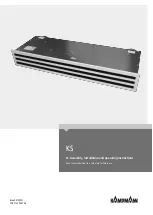
ELECTRIC HEAT START-UP
Rotating parts and electrical shock haz-
ards exist. Lock out and tag out the fan
motor(s) and heat power disconnects be-
fore servicing. FOLLOW THE LATEST
“LOCKOUT TAGOUT” PROCEDURE.
Failure to follow proper safety precau-
tions may result in serious injury or death.
All electrical connections in the heater, including both
field and factory made connections, should be checked
for tightness before operating the heater. In addition,
after a short period of operation, all connections should
again be checked for tightness.
DO NOT operate electric heat below the
minimum airflow requirement. Minimum
airflow requirement for blow thru electric
heaters is 70 CFM / KW.
A visual inspection of the heater elements should be
made prior to use of the heater. If physical damage is
evident, a Megohm test should be used to validate the
heater elements are safe for use. If a minimum value
of 10 Megohms is not achieved then any damaged ele-
ments or ceramic insulators must be replaced prior to
operation.
Ensure filters are clean and airflow is at
minimum requirement or greater. Prefer-
ably 100% for this start up procedure.
To operate this heater make sure all associated control
equipment is on, energize main supply disconnect and
set controlling thermostat above ambient temperature.
This heater is equipped with automatic and manual re-
set temperature limiting controls. If it fails to operate,
make sure manual resets are operative by pushing reset
buttons.
BEFORE START-UP CHECK
Thorough safety precautions should always be taken
when performing startup and service. Only qualified
individuals should perform these tasks.
Before entering the fan section, make sure that the fan
electrical power source is disconnected, locked and
tagged out in the “OFF” position.
1. Check that the unit is completely and properly
installed with ductwork connected. Check that
all construction debris is removed, and filters are
cleaned.
2.
Check that all electrical work is finished and prop
-
erly terminated. Check that all electrical connec-
tions are tight and that the proper voltage is con-
nected.
3. Motor and Ball bearings on fan shaft are pre-lu-
bricated and do not need grease before startup.
4. Check tightness of setscrews in bearings and fan
wheel(s). Make sure setscrews are torqued per
Table 1. (see
Table 1 on page 22)
Equipment damage due to loose setscrews
or fasteners represents improper start-up
and equipment abuse. It is not covered by
the warranty.
5. Check tightness of sheave setscrews and/or
capscrews. Check alignment of fan and motor
sheaves and belt tension.
6. Rotate shaft manually by hand to make sure it is
free.
7. Fan Startup: Start Fan, and observe the rotation. If
the fan is operating backward, disconnect power
and reverse two legs of the 3-phase supply power.
8. To ensure that water connections and joints are
tight, leak test the piping systems.
9. Check that condensate drain is trapped.
START-UP
Units are not intended for temporary heat/cool or venti-
lation. Units are not designed or equipped to operate in
dusty environments. Filters may not provide adequate
protection when the unit is operated in a construction
environment. Operation of the units in conditions out-
lined above could result in damage to the equipment
or buildings and furnishings and void all manufacturer
warranty.
ENVIRO-TEC
19
FORM ET102.19-NOM1 (0521)
3
SECTION 3 - STARTUP
Содержание MQL B Series
Страница 8: ...THIS PAGE INTENTIONALLY LEFT BLANK ENVIRO TEC 8 FORM ET102 19 NOM1 0521 LIST OF FIGURES...
Страница 12: ...THIS PAGE INTENTIONALLY LEFT BLANK ENVIRO TEC 12 FORM ET102 19 NOM1 0521 Section 1 introduction...
Страница 18: ...INTENTIONALLY LEFT BLANK ENVIRO TEC 18 FORM ET102 19 NOM1 0521 Section 2 installation...
Страница 35: ...5 ENVIRO TEC 35 Section 5 TROUBLESHOOTING FORM ET102 19 NOM1 0521...















































